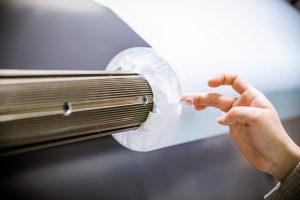NanoLayr’s sustainability roadmap charts the way
Article from Dr.Barbara Nebel,CEO, thinkstep-anz
Want to make your manufacturing business more environmentally and socially sustainable?
When you’re a busy manufacturer, investing in a sustainability roadmap can be the difference between talking about sustainability and making it happen.
In this article we explain what a sustainability roadmap is and why your business needs one. We also talk with Auckland-based functional textile manufacturer NanoLayr about the benefits it’s seeing from theirs.
What is a sustainability roadmap?
A sustainability roadmap charts the course your business plans to take to become more environmentally and socially sustainable.
Think of it like a Google map. Plug in your destination (a more sustainable manufacturing business) and Google offers up a host of ideas to help you with your journey.
- Street names and directions? These are the high-level sustainability actions you need to take to reach your destination. In a manufacturing business they may include sourcing renewable materials or tackling waste in your packaging.
- Alternative routes? Think of these as your options and trade-offs. There are many ways to become more sustainable. You’ll need to assess different projects and prioritise them.
- Distances and different modes of transport? These are the resources you’ll need to commit and the people you’ll need to involve: team members with clear responsibilities, external stakeholders such as suppliers, and (probably) some budget.
- Journey times? They’re the high-level timelines you’ll work to. Map your sustainability actions into blocks of time. You may be able to complete some within six months to a year. Other activities will take longer. Assign them over the medium term (say one to two years) and longer term (say two years plus).
Bring this ‘journey’ information together and you have your sustainability roadmap: a summary of your sustainability goals and the projects, resources and timetable that will help you meet them.
NanoLayr’s sustainability roadmap

NanoLayr is an award-winning deep-tech manufacturer and exporter. The company uses its proprietary Sonic Electrospinning Technology to manufacture functional nanofibre textiles. NanoLayr textiles feature in advanced air filters, skincare brands and sound insulation around the world.
Sustainability matters to NanoLayr. ‘It’s the right thing to do,’ says CEO Ray Connor. ‘As a manufacturer, we have a responsibility to make sure the products we make and how we make them have minimal impact on people – our customers, employees, suppliers and communities – and the environment.’
Earlier this year NanoLayr brought together 15 team members from their executive and senior teams to brainstorm and develop the company’s first sustainability roadmap. Participants came from across the business: product development, operations, R&D, health and safety, manufacturing, design, customer engagement, marketing and business development. Read on to learn how the roadmap is helping them.
How can a sustainability roadmap benefit your business?
- A roadmap confirms your destination
Where are you heading and why? To answer these questions, the United Nations’ 17 Sustainable Development Goals (SDGs) are a good place to start. Every country on earth has ratified these environmental, social and economic goals.
We recommend you choose five or six goals to focus on. Which are the most relevant to your business? Where can you have greatest impact?
In producing their sustainability roadmap, NanoLayr chose to focus on five SDGs: Good Health and Wellbeing (SDG 3), Decent Work and Economic Growth (SDG 8), Responsible Consumption and Production (SDG 12), Climate Action (SDG 13) and Life Below Water (SDG 14). SDG 17 (Partnerships for the Goals) supports all the goals. The team found mapping to the SDGs helpful.
‘It’s given us a framework to identify the priority areas we need to work on, to make the biggest difference,’ says Ray.
- A roadmap defines your starting point (‘You are here’)
The most helpful maps, including Google, show you where you’re starting from. In sustainability terms, your starting point is a stocktake of the activities you’ve completed and have underway.
When you do this stocktake, you may be pleasantly surprised. NanoLayr’s roadmap identified that the company is already making good progress towards many of its sustainability goals. For example, many of the ingredients it uses and the raw materials in its packaging are bio-degradable and derived from plants.
With a roadmap in place, the company can build on these ‘starter’ activities to achieve even more. For example, it can investigate options to ‘trace’ the source of its raw materials through its supply chain. This activity will help it market products in international markets where ‘traceability’ is increasingly important.
- A roadmap breaks your journey into steps
Here we’re talking priorities and projects. In Google terms, which streets should you take? Where do you need to turn? How far along do you need to go?
On your sustainability roadmap, these are your activities, timelines, responsibilities and budgets. Many manufacturers already have a list of sustainability projects in their sights. If you’re looking for inspiration, the SDG Compass contains practical activities to link your strategies to the global agenda.
Ray says NanoLayr’s sustainability roadmap is helping the business prioritise what it does.
‘The framework has given us the tools to map out our sustainability journey so we can focus on the right things.”
- A roadmap shows people where you’re going
A roadmap is also a communication tool. Use it to help your stakeholders understand where you’ve come from and where you’re heading to. Engage your team behind your plan, educate your suppliers and show your customers that sustainability matters to you.
Tailor your roadmap to your audiences. They’ll want different information, presented in different ways. In the spirit of ‘maps’, most people value something visual like a simple one-page diagram.
Ray says NanoLayr is using its roadmap, and the SDGs it is built on, to communicate with its customers.
‘Many global companies have adopted the SDGs, so using them ourselves lets us speak a common language with our customers.’
Want to make your manufacturing business more environmentally and socially sustainable?
A roadmap will help you find your way!



